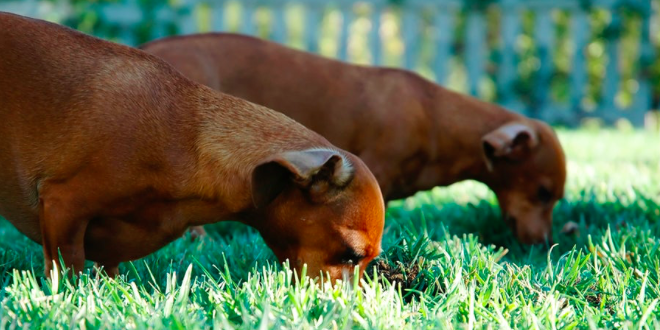We all love our dogs, but the yellow patches their urine leaves on our lawns is not so appealing…
The Facts
Dogs have a high level of nitrogen in their urine, so when they go to the toilet on your lawn, the concentrated amount of this chemical often burns the grass. Lawn burn is usually worse with large dogs (for obvious reasons!), as well as female dogs because they squat to urinate and empty their entire bladder at once, whereas male dogs aim at trees, bushes or fences in a variety of places.

Prevention & Treatments
What you feed your dog can have a big effect on the state of your grass. Feed your canine the highest quality food your budget will allow, ensuring it doesn’t exceed the recommended protein requirements. Excessive protein or low-quality protein can increase the nitrogen content of your dog’s urine. It’s also important to provide your pooch with plenty of water to dilute the nitrogen in its urine.
A doggy bathroom can be another alternative. Training your dog to do his business in one area of your garden can be easily achieved. This not only prevents lawn burn but confines the odour to one area, too!
Supplements are also available, such as Dog Rocks and Green-Um which can be added to your dog’s food or water to help neutralise the nitrogen in its urine.
How you look after your lawn will also have an effect on its susceptibility to yellow patches. A well-maintained lawn that’s free of disease and weeds will be less prone to damage from your dog’s urine. Water it regularly, especially during summer, as this will dilute the concentration of the nitrogen reaching the grass. If you are planting or reseeding a lawn, be aware that certain types of grass are more resistant to lawn burn than others. These include rye grasses and fescues or a mix of both, such as RyeAgra.
Warren Lippi-Smith from Rapid Lawn, which produces RyeAgra, offers the following advice for keeping your lawn in tip-top shape and less vulnerable to the toileting habits of your dog:
Avoid mowing your lawn too short, which lets the sun access the soil where the weed seeds are dormant. Mow your lawn to a minimum height of 5cm and it will need watering less as moisture won’t instantly evaporate because the soil is shaded by longer grass blades.
It’s not rocket science, but watering is the key ingredient. With new lawns, keep the seed moist, but avoid creating puddles of water. With established lawns, give your grass long watering sessions about three to four times per week to encourage deep root growth.
‘Little and often’ is crucial when it comes to fertiliser. Don’t wait until your lawn is already showing yellow tinges! Apply approximately 2.5kg per 100sqm every three to four weeks, ensuring you water the lawn heavily before and after application. And keep the fertilizer out of reach of your pets!
Article supplied by pet.co.nz
Visit pet.co.nz for all your pet’s needs.









Join the Discussion
Type out your comment here:
You must be logged in to post a comment.